Search the Special Collections and Archives Portal
Search Results
Robert Scott Hooper Photographs [UNPROCESSED]
Identifier
Abstract
This collection is unprocessed; see the access note for additional information. The Robert Scott Hooper Photographs (approximately 1960-2019) consist of photographic negatives, positives, prints, Polaroids, 16mm films, videos, business records, correspondence, drawings, and ephemera. The collection was created by prolific photographer Robert Scott Hooper and his longtime business partner and wife, Theresa Holmes. The couple's life and business was based in Las Vegas, Nevada. Hooper's work focused on the female form, encompassing many areas of interest including sexual entertainment, modeling, pornography, and Las Vegas entertainment. Hooper was a contributing photographer with Playboy and Vegas Visitor magazines. Hooper also photographed many celebrities, Las Vegas production shows, notable events like hotel implosions, and the development of the Las Vegas Strip, including early time-lapse work on the Luxor Hotel and Casino and The Venetian. This collection also includes business records, model contracts, and correspondence.
Archival Collection
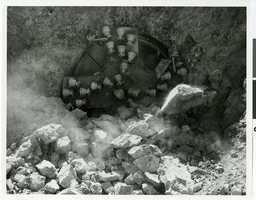
Photograph of the "Mole" Jarva Tunnel Borer breaking through the tunnel on the Las Vegas River Mountain Project, Las Vegas, Nevada, circa 1968-1971
Date
Archival Collection
Description
Image
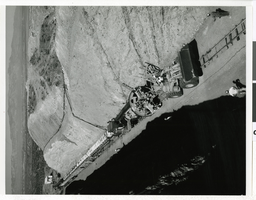
Photograph of the 988 caterpillar loader towing mole and conveyor to the tunnel portal used on the Las Vegas River Mountain Project, Las Vegas, Nevada, circa 1968-1971
Date
Archival Collection
Description
Image
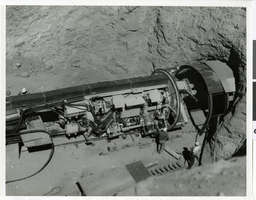
Photograph of the outlet portal showing the mole preparing to walk into the tunnel on the Las Vegas River Mountain Project, Las Vegas, Nevada, circa 1968-1971
Date
Archival Collection
Description
Image
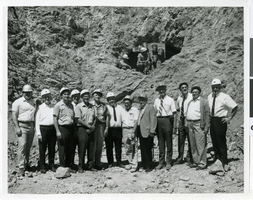
Photograph of Key federal, state and contractor representatives who were on hand when the mole broke through the tunnel, Las Vegas, Nevada, 6-26-69
Date
Archival Collection
Description
Image
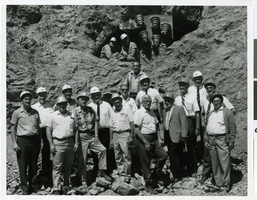
Photograph of Key federal, state and contractor representatives who were on hand when the mole broke through the tunnel, Las Vegas, Nevada, 6-26-69
Date
Archival Collection
Description
Image
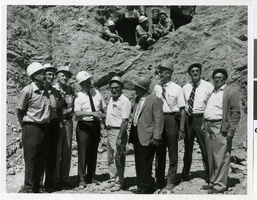
Photograph of Key federal, state and contractor representatives who were on hand when the mole broke through the tunnel, Las Vegas, Nevada, 6-26-69
Date
Archival Collection
Description
Image

Casiano Corpus Jr. oral history interview: transcript
Date
Archival Collection
Description
Oral history interview with Casiano Corpus Jr. conducted by Cecilia Winchell and Stefani Evans on February 14, 2023 for the Reflections: the Las Vegas Asian American and Pacific Islander Oral History Project. In this interview, Corpus Jr. details a difficult childhood in the Philippines, where society is highly socioeconomically stratified. He recalls his parents working a number of jobs to support their large family, and as soon as he finished his primary schooling, he also started working in construction. When his father was finally petitioned by his uncle to move to the United States, Corpus was at first reluctant to go, since he had a familiar life in the Philippines, but has come to love the United States and the life he created for himself. Immediately after moving to the United States, their family landed in Las Vegas, Nevada, and Corpus began working a number of jobs. He started out as a busboy at a Chinese restaurant before deciding that he wanted to work in a casino and moved to Union Plaza. His current job is as a porter at Palace Station, where he has been for the past 31 years. He has also been working to unionize Palace Station and Station casinos with the Culinary Union for the past twelve years. He talks about the hunger strike he organized, why he organizes with no fear, and what he hopes to see out of his efforts throughout the interview.
Text
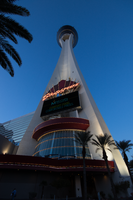
Photographs of Stratosphere signs, Las Vegas (Nev.), March 6, 2017
Date
Archival Collection
Description
Site address: 2000 S Las Vegas Blvd
Sign owner: American Casino and Entertainment Properties
Sign details: This location was the site of Bob Stupak's Vegas World that opened in 1979. The Stratosphere opening in this location in 1996, the Stratosphere includes the tallest freestanding observation tower in the United States. Developed by Bob Stupak, the Stratosphere was meant to be a landmark for the city of Las Vegas. As the years progressed, plans for restaurants and thrill rides came to fruition and the hotel now boasts several popular attractions. From 1996 to 2010, the Stratosphere went through bankruptcy, remodeling, renovations, additions, and new ownership. The current owner, American Casino and Entertainment Properties, also owns three other properties in the Las Vegas area.
Sign condition: About 4-5, appears to have relatively low damage, if any
Sign form: Porte cochere near main entrance
Sign-specific description: Stratopshere in orange neon, three vertical, squiggly lines (red, blue) pointing up toward triangular shape; second neon sign on right side of front facade, "Stratopshere" in orange, overlaid on top of blue cloud shape and orange, poles
Sign - type of display: Neon and plastic back lit sign
Sign - media: Steel and Electronic Media Screen
Sign - non-neon treatments: Electronic Media Screen and plastic back lit sign
Sign animation: Flashing for the design behind their logo on their sign
Sign environment: Located on the North end of the strip on Sahara, just across the street from the SLS Casino.
Sign architect of record: Skidmore, Owings, and Merrill
Sign - date of installation: Circa 1996 around opening
Sign - date of redesign/move: Around 2014/15 the background colors of the sign switched from a blue sky color to a pink/purple design.
Sign - thematic influences: Design similar to radio transmission towers; Stupak compared his design to Eiffel Tower and Space Needle (Seattle).
Survey - research locations: Stratosphere website http://www.stratospherehotel.com/?&mkwid=s0JHs4Hf3_dc&pcrid=102775265532&pkw=stratosphere%20las%20vegas&pmt=p&gclid=CjwKCAjwhOvPBRBxEiwAx2nhLp_Mtg7n6c-FUkbwYgY8MD3TJzgUWEp4WX1IgzePUlk1y-Rat_wmexoCJs8QAvD_BwE, recorder's office, Assessor's page
Survey - research notes: The top of the Stratosphere has blinking lights, but it is not confirmed if they are LED or Neon.
Surveyor: Carlyle Constantino
Survey - date completed: 2017-07-12
Sign keywords: Porte-cochère; Neon; Plastic; Steel; Flashing; Video screen; Incandescent
Mixed Content
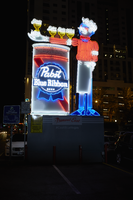
Photographs of Pabst Blue Ribbon sign, Las Vegas (Nev.), June 28, 2017
Date
Archival Collection
Description
Site address: Fremont St and Las Vegas Blvd
Sign owner: PBR Donated, but a part of Fremont Street East
Sign details: PBR held a revealing party when installed in 2015, right next to The Park on Fremont. YESCO manufactured the 30 feet tall sign is nicknamed Cool Blue. Previous to this sign in this location the Maharaja Hookah Cafe had their signage in the same location previous to 2013.
Sign condition: 5, just installed in 2015 so neon and paint are still in great condition
Sign form: Free Standing Sign
Sign-specific description: 30 feet tall, the sign is nicknamed Cool Blue. A 30 foot waiter holding his arm out with 3 beers on his arm and one in his hand. The beers are animated with them lighting up in order starting with the one closest to his body. His arm is resting on a PBR can. The waiters shirt and cheeks illuminate red neon while the rest of his body illuminates blue argon. The PBR beer can illuminates red and blue as well.
Sign - type of display: Neon
Sign - media: Steel
Sign animation: The Beer cans on the waiters arm light up in order, starting with the one closest to his body.
Sign environment: This is located in the parking lot on the corner of Las Vegas Blvd. North and Fremont St. East next to the Park on Fremont. This marks the beginning of the Fremont Street East District were other freestanding Neon signs are as well.
Sign manufacturer: YESCO
Sign - date of installation: 2015
Sign - thematic influences: The retro theme makes it look like a throwback to 1950s/60s advertisement. Also since it is for a beer company it shows that Neon does not always have to be for the Casinos here in Vegas. This is one of the first freestanding signs you see in the Fremont Street East District, thus showing that the Neon community downtown still is thriving and still defines our culture here.
Survey - research locations: YESCO website http://www.yesco.com/news/yesco-installs-pabst-blue-ribbon-neon-sign/ , Vital Vegas website https://vitalvegas.com/downtowns-fremont-east-gets-a-new-neon-sign-courtesy-of-pbr/ , google map roadside view
Survey - research notes: Since this is a freestanding sign it is difficult to find any specific information on a single owner or why this sign was placed there specifically.
Surveyor: Emily Fellmer
Survey - date completed: 2017-07-22
Sign keywords: Neon; Steel; Back to back; Monument sign
Mixed Content
